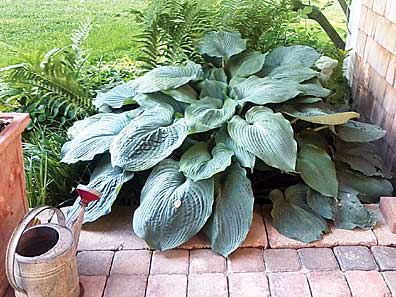
Hosta is a perennial foliage plant that is so well known and widely planted that many gardeners take it for granted. There are over 3,000 named varieties, all of them easy to grow and very trouble-free. They are known for growing well in shady spots where most flowers struggle, just one of the many reasons they deserve a place in your garden.
Also known as Plantain Lilies, Hostas can be used to create dramatic effects in problem areas. They are very comfortable under trees, where they can be used like a tropical ground cover since they don’t mind competition from tree roots. They will thrive in complete shade, so they are a perfect way to fill narrow beds between walks and walls on the north side of buildings. Once they are established they are very drought-tolerant and carefree.

Hostas are named after Nicklaus Host, the first director of the botanical garden at the Belvedere Palace in Vienna, Austria. Built in the early 1700’s, Belvedere is an elaborate complex with a museum and formal gardens in the style of Versailles.
Botanically, Hostas are in the Lily family, but they are also related to asparagus. They send up tall shoots with blooms, similar to asparagus stalks. Most Hosta blooms are lavender in color, but some are white. There are several fragrant Hosta varieties, but most Hosta blooms are not fragrant.
Hosta plants vary in size. We have some huge Hostas in our gardens, but there are also some adorable tiny ones like “Mouse Ears” and “Stiletto”. Big Hostas like “Blue Angel”, “Big Daddy” and “Sum & Substance” can get four feet across, and clumps will gradually spread and form new plants. It is easy to divide Hosta clumps.
Deer and slugs are the main enemies of Hosta plants. We’ve discovered a nutritional supplement tablet for plants that contains Bitrex, and this is a terrific way to discourage deer. Simply press a tablet into the soil right next to the plant. The best thing we’ve found for controlling slugs is “Sluggo” by Monterey, an organic remedy that’s safe around edibles like strawberries (another slug favorite).
Planting Hostas is easy. They aren’t picky about soil, but we like to mix some Plant Tone into the soil when we plant them so their roots will get established quickly. Hosta roots are fairly shallow so you don’t need to dig much. It’s important to plant them where they get protection from the hot afternoon sun; if they get sunburn the edges of the leaves will turn brown and crinkle up.
We’ve started using variegated Hostas as perennial borders around our landscape beds. Varieties with bright white or yellow in the leaves, like “Patriot”, “Loyalist” and “Fire & Ice”, make a stunning accent along the edges of beds. Bright green Hostas like “Sum & Substance” and “Guacamole” really brighten up shade gardens. Blue Hostas like “Krossa Regal” and “Blue Ice” are big favorites. We always have a good selection at our garden center. To see hundreds of varieties in one place, visit the Chadwick Arboretum at Ohio State University.
Steve Boehme is the owner of GoodSeed Nursery & Landscape, located at 9736 Tri-County Highway, near Winchester, Ohio. To e-mail your landscaping questions click “Contact Us” from their website at www.goodseedfarm.com or call (937) 587-7021.
